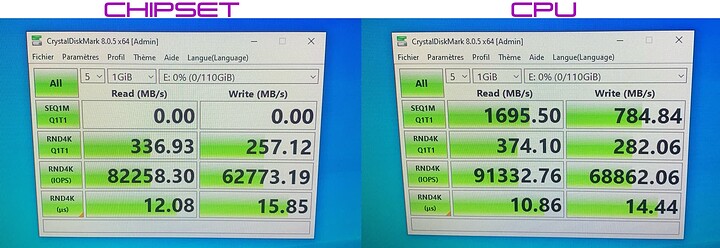Heya, I did try looking through this thread, but couldn’t find any such commands myself.
But some interesting results came out of what you suggested I try… For each of the below 3 scenarios, I ran the exact fio command I shared in my last post 5 times in a row, with a 1 second sleep between each run (this is why there are 5 results per test case):
First, Ableconn, pcie4 (with AER enabled – no errors reported in dmesg):
read: IOPS=117k, BW=458MiB/s (480MB/s)(5000MiB/10928msec)
write: IOPS=87.8k, BW=343MiB/s (360MB/s)(5000MiB/14580msec); 0 zone resets
read: IOPS=120k, BW=467MiB/s (490MB/s)(5000MiB/10708msec)
write: IOPS=90.3k, BW=353MiB/s (370MB/s)(5000MiB/14175msec); 0 zone resets
read: IOPS=121k, BW=475MiB/s (498MB/s)(5000MiB/10536msec)
write: IOPS=92.9k, BW=363MiB/s (381MB/s)(5000MiB/13771msec); 0 zone resets
read: IOPS=120k, BW=469MiB/s (491MB/s)(5000MiB/10668msec)
write: IOPS=91.3k, BW=357MiB/s (374MB/s)(5000MiB/14025msec); 0 zone resets
read: IOPS=118k, BW=461MiB/s (483MB/s)(5000MiB/10849msec)
write: IOPS=88.1k, BW=344MiB/s (361MB/s)(5000MiB/14530msec); 0 zone resets
Second, Ableconn, pcie3 (with AER enabled – no errors reported in dmesg):
read: IOPS=109k, BW=425MiB/s (446MB/s)(5000MiB/11755msec)
write: IOPS=88.8k, BW=347MiB/s (364MB/s)(5000MiB/14415msec); 0 zone resets
read: IOPS=110k, BW=430MiB/s (450MB/s)(5000MiB/11639msec)
write: IOPS=93.5k, BW=365MiB/s (383MB/s)(5000MiB/13685msec); 0 zone resets
read: IOPS=105k, BW=412MiB/s (432MB/s)(5000MiB/12147msec)
write: IOPS=83.9k, BW=328MiB/s (344MB/s)(5000MiB/15259msec); 0 zone resets
read: IOPS=112k, BW=438MiB/s (459MB/s)(5000MiB/11412msec)
write: IOPS=94.5k, BW=369MiB/s (387MB/s)(5000MiB/13551msec); 0 zone resets
read: IOPS=108k, BW=423MiB/s (443MB/s)(5000MiB/11824msec)
write: IOPS=84.6k, BW=330MiB/s (347MB/s)(5000MiB/15129msec); 0 zone resets
Third, and most interestingly, pci3, with the m.2 → u.2 adapter cable that comes with Optane 905p drives:
(EDIT: this third case is actually running at pci4, not pci3 – see my next post)
read: IOPS=122k, BW=475MiB/s (498MB/s)(5000MiB/10519msec)
write: IOPS=95.8k, BW=374MiB/s (392MB/s)(5000MiB/13363msec); 0 zone resets
read: IOPS=124k, BW=484MiB/s (508MB/s)(5000MiB/10322msec)
write: IOPS=97.6k, BW=381MiB/s (400MB/s)(5000MiB/13114msec); 0 zone resets
read: IOPS=120k, BW=468MiB/s (491MB/s)(5000MiB/10675msec)
write: IOPS=90.9k, BW=355MiB/s (372MB/s)(5000MiB/14085msec); 0 zone resets
read: IOPS=126k, BW=494MiB/s (518MB/s)(5000MiB/10123msec)
write: IOPS=99.3k, BW=388MiB/s (407MB/s)(5000MiB/12886msec); 0 zone resets
read: IOPS=126k, BW=494MiB/s (518MB/s)(5000MiB/10121msec)
write: IOPS=99.0k, BW=387MiB/s (406MB/s)(5000MiB/12923msec); 0 zone resets
So, you are correct that pci4 is faster than pci3 for the same connection method… but for some reason, the m.2 → u.2 adapter results in measurably more IOPS (it is not quite 7% in this test, though).
P.S. Adding one additional test result for you, as well… this is a single run of the above tests, still using the m.2 → u.2 connector, but this time, on a /dev/mapper/p5800x encrypted target:
read: IOPS=64.6k, BW=252MiB/s (265MB/s)(5000MiB/19810msec)
write: IOPS=46.2k, BW=180MiB/s (189MB/s)(5000MiB/27713msec); 0 zone resets
Feel free to let me know if you have ideas at all on how I might be able to speed that one up  I assume that there isn’t much that can be done for the encrypted case. I would be happy to try anything at all though.
I assume that there isn’t much that can be done for the encrypted case. I would be happy to try anything at all though.
